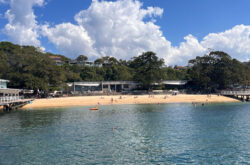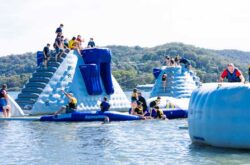Living near beautiful bushland in Sydney comes with risk… and that’s bushfires. All families need to have a Bushfire Plan and know what they’re going to do if a bushfire comes near their home. In this guide, we outline how to prepare for bushfire season and what to do should an emergency strike. Be prepared for Summer 2023!
The 2019-2020 bushfire season (black summer fires) was the worst on record for New South Wales, with 26 lives lost, 2,448 homes destroyed and 5.5 million hectares of land burnt. The 2023/24 season is almost here, and communities are being urged to prepare for what is likely to be the most significant bushfire season since the black summer fires.
“Almost the entire country can expect drier and warmer conditions than normal this spring, so it is important for Australians be alert to local risks of bushfire over the coming months, regardless of their location.” – Chief Executive of the Australasian Fire Authorities Council (Afac).
There has been plenty of smoke in the air over the past few weeks the NSW National Parks and Wildlife Service (NPWS) and the NSW Rural Fire Service (RFS) conduct multiple hazard reduction burns in national parks across Greater Sydney. The burns will reduce bushfire fuel, including dry leaves, sticks, branches and small shrubs, in strategic areas of the parks. This will lessen the spread and intensity of future bushfires and help protect nearby private properties and community assets.
Tips to prepare for bushfire season
Keep your valuables ready
- Pack passports, documents valuables, sentimental and a bag of clothes, ready to go.
- Take photos or video of your house for insurance purposes.
Prepare your home
- Clean leaves from gutters, roofs and downpipes regularly, and fit quality metal leaf guards.
- Install fine steel wire mesh screens on all windows, doors, vents and weepholes.
- Fit metal NOT plastic fly screens on windows and doors.
- Enclose open areas under your decks and floors.
- Seal all gaps in external roof and wall cladding.
- When installing LPG cylinders around your home, make sure that pressure relief valves face outwards so that flame is not directed towards the house.
- Keep your backyard tidy, free from any buildup of flammable material.
- Relocate any flammable items away from your home including woodpiles, paper, boxes, crates, hanging baskets and garden furniture.
- Remove excess ground fuels and other combustible material.
- Make sure that if there is a fire hydrant outside your home it is easily located and not obstructed.
Prepare your garden
- Mow your grass regularly, both in the front and back yards.
- Do not deposit tree loppings, grass clippings and other materials that could aid a fire on your property, or on council reserves or bushland.
- Ensure your garden hoses are long enough to reach the perimeter boundary of your property.
- Plant trees and shrubs that are less likely to ignite due to their lower oil content.
- Trim low-lying branches two metres from the ground surrounding your home.
- If you have a swimming pool, have a Static Water Supply sign placed on your front fence. Contact your local fire station for information.
- Consider purchasing a portable pump to use from your swimming pool or water tank.
Ensure you are adequately insured
- Check your home insurance policy is up-to-date and that you are adequately covered for full building replacement and contents. You may only have a small increase in monthly fees to insure your home to its full rebuilding value!
If you haven’t allowed time to leave your home and can’t escape…
- Comply with police if ordered to evacuate.
- Stay calm.
- Don’t enter the bush if smoke or fire is in the area.
- Report all fires (not smoke), ring 000.
- Patrol the outside of your home, putting out any embers and spot fires that may start.
- Close all windows, doors and shutters.
- If possible, block your downpipes (a sock full of sand/soil will help) and fill roof gutters with water.
- If possible, block gaps beneath doors with wet blankets or towels.
- Collect water in buckets/bath.
- Bring your garden hose inside so that it won’t melt in the fire and can still be used.
- Wet down timber decks and gardens close to the house if the fire is approaching.
- Do not stand on your roof with your hose. In bushfires, often more people are injured by falling from roofs than suffering burns.
- Keep ladders, shovels and metal buckets at hand to help put out spot fires.
- Keep a torch and a portable battery-operated radio in the home in case electricity supply fails.
- Drink plenty of water so you do not dehydrate.
- Move any firefighting equipment to a place that it will not get burnt.
Neighbourhood Safer Places on the North Shore
Neighbourhood safe places are places of last resort during a bushfire emergency and are to be used only when all other options in your bushfire survival plan can’t be put into action safely. Safe places are listed by Local Government Area to help you prepare for bushfire season, are:
Lane Cove Council
- Bayview Park, Bay Street, Greenwich
- Woodford Bay Bicentennial Reserve, Kelly’s Esplanade, Longueville
- Pottery Green, Phoenix Street, Lane Cove
- Kingsford Smith Oval, Kenneth Street, Longueville
- Linley Point Reserve, 348 Burns Bay Road, Lane Cove
- Saint Ignatius College – Junior School Oval, College Road South, Riverview
- Marjorie York Playground, 61 Tambourine Bay Road, Riverview
Willoughby Council
- Gore Hill Oval, Pacific Highway, St Leonards
- Northbridge Plaza Carpark, Harden Avenue, Northbridge
- Chatswood Park, Orchard Road, Chatswood
- Willoughby Park, Warrane Road, Willoughby East
- Willoughby Leisure Centre Car Park, 2 Small Street, Willoughby
Ku-ring-gai Council
- Burt Oldfield Oval, Killara
- Regimental Park, Killara
- Kent Oval, North Turramurra
- North Turramurra Recreation Area (Golf Course), North Turramurra
- Sandakan Park, North Turramurra
- Robert Pymble Park, Pymble
- Roseville Park, Roseville
- St Ives Village Green, St Ives
- Turramurra Memorial Park, Turramurra
- Claude Cameron Grove, Wahroonga
Hornsby Shire Council
- Middle Dural Public School, Cnr of Old Northern Road and Middle Dural Road, Middle Dural
- Storey Park, Lodge Street, Hornsby
- Waitara Park, Waitara Avenue, Hornsby
- Campbell Park, Wilga Street, West Pennant Hills
- Edward Bennett Oval, 45 Edward Bennet Drive, Cherrybrook
- Dural Salvation Army, 277 New Line Road, Dural (access off Old Northern Road)
- Hornsby Rural Sports Facility, 18-20 Bayfield Road, Galston, Galston
- Mountview Oval Club House, Kookaburra Road, Hornsby Heights
- St Bernards Parish, Warrina Street, Berowra Heights
- Ruddock Park, Coral Heath Ave, Westleigh
- Brickpit Park Stadium, 1A Dartford Road, Thornleigh
- Asquith Park, Mills Avenue, Asquith
- Cowan Public School, Franser Road, Cowan
Ryde Council
- Carpark Macquarie Shopping Centre, Talavera Road, Macquarie Park
- Monash Park, Cnr of Ryde Road and Monash Road, Gladesville
Evacuation centres in Ku-ring-gai
- East Lindfield Memorial Hall – 9 Wellington Road, East Lindfield
- Roseville Chase Community Hall – 7 Babbage Road, Roseville
- Lady Game Kindergarten – 43 Lady Game Drive, Lindfield
- Presbyterian Church of Australia – 14 Stuart Street, Wahroonga
- St Andrews Anglican Church – 2 Water St, Wahroonga
- Uniting Church Gordon – 18 Cecil St, Gordon
- West Pymble Community Hall – 30 Loftberg Road, West Pymble
For the latest information on the bushfire emergency visit www.rfs.nsw.gov.au or download the Fires Near Me app.












